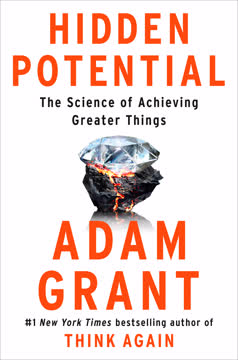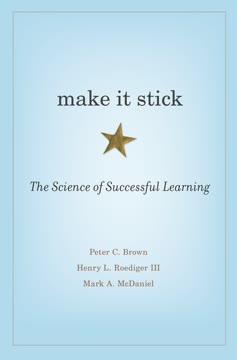Key Takeaways
1. Emotional Intelligence: The Foundation of Leadership Excellence
Like it or not, leaders need to manage the mood of their organizations.
The power of EI. Emotional intelligence (EI) is twice as important as other skills in determining outstanding leadership. It encompasses self-awareness, self-management, social awareness, and relationship management. Leaders with high EI can effectively manage their own emotions, relate well to others, and create a positive organizational climate.
EI can be developed. While some aspects of EI are innate, it can be learned and improved over time. Key strategies include:
- Practicing mindfulness and self-reflection
- Seeking honest feedback from others
- Working with a coach or mentor
- Deliberately putting yourself in challenging situations to grow
EI in action. Emotionally intelligent leaders:
- Read and influence the emotional state of their teams
- Make better decisions by considering both logic and feelings
- Build strong, trusting relationships
- Navigate change and uncertainty more effectively
- Inspire and motivate others through their words and actions
2. Self-Awareness: Understanding Your Emotions and Behaviors
You can't manage emotions without knowing what they really are.
Recognize and label emotions. Self-awareness is the foundation of emotional intelligence. It involves accurately identifying your emotions, understanding their triggers, and recognizing how they impact your thoughts and behaviors. Develop a richer emotional vocabulary to precisely name what you're feeling, going beyond basic terms like "angry" or "sad."
Assess your strengths and weaknesses. Regularly reflect on your emotional patterns, communication style, and impact on others. Seek feedback from trusted colleagues and friends to gain a more complete picture of yourself. Be open to constructive criticism and willing to acknowledge areas for improvement.
Techniques for building self-awareness:
- Keep an emotion journal to track patterns
- Practice mindfulness meditation
- Use the "Self-Compassion Break" exercise
- Take personality assessments (e.g., MBTI, Big Five)
- Ask for specific, behavioral feedback from others
- Reflect on your core values and how they align with your actions
3. Manage Your Emotions: Turn Feelings into Valuable Data
Emotions are signals, beacons that show you that you care about something.
Emotions as information. Instead of trying to suppress or ignore emotions, view them as valuable data. They provide insights into what matters to you, potential conflicts, and areas that need attention. When you feel a strong emotion, pause to consider what it's telling you about the situation and your values.
Strategies for emotional regulation:
- Practice reframing negative thoughts
- Use the "name it to tame it" technique for strong emotions
- Engage in physical exercise or relaxation techniques
- Take a break to gain perspective
- Practice self-compassion
From reactivity to responsiveness. Develop the ability to pause between feeling an emotion and acting on it. This creates space for more thoughtful, intentional responses. When facing a challenging situation:
- Recognize the emotion
- Take a deep breath
- Consider the bigger picture
- Choose a response aligned with your values and goals
4. Everyday EI: Navigating Emails, Meetings, and Difficult Conversations
Human communication for the digital age.
Emotionally intelligent communication. Apply EI principles to daily workplace interactions to improve relationships, productivity, and outcomes. Key areas to focus on:
-
Emails:
- Consider the recipient's perspective and emotional state
- Use clear, concise language to avoid misinterpretations
- Be mindful of tone and use emojis or exclamation points judiciously
- For sensitive topics, consider face-to-face or phone conversations
-
Meetings:
- Set a positive tone from the start
- Encourage participation from all attendees
- Address conflicts or tensions proactively
- End with clear action items and appreciation
-
Difficult conversations:
- Prepare emotionally and logistically
- Use "I" statements to express your perspective
- Listen actively and empathetically
- Focus on finding solutions, not assigning blame
The power of non-verbal cues. Pay attention to body language, tone of voice, and facial expressions (both your own and others') to enhance understanding and connection in all interactions.
5. Dealing with Difficult People: Transform Rivals into Allies
Make your enemies your allies.
The 3Rs approach. When facing a challenging relationship or rivalry, use the following steps to build trust and collaboration:
- Redirection: Shift negative emotions away from you
- Reciprocity: Give before you ask
- Rationality: Establish clear expectations
Strategies for specific difficult personalities:
- Passive-aggressive colleagues: Address the underlying issues directly
- Toxic handlers: Set boundaries and encourage self-care
- Emotional vampires: Limit exposure and practice emotional detachment
Turn conflicts into opportunities. View difficult interactions as chances to:
- Improve your own emotional intelligence
- Build stronger, more resilient relationships
- Uncover innovative solutions to problems
- Enhance your reputation as a skilled communicator and leader
6. Empathy: The Key to Connecting and Influencing Others
Three types critical for leaders.
The empathy triad. Develop all three types of empathy to enhance your leadership effectiveness:
- Cognitive empathy: Understanding others' perspectives
- Emotional empathy: Feeling what others feel
- Empathic concern: Sensing and responding to others' needs
Cultivating empathy:
- Practice active listening without judgment
- Ask open-ended questions to understand others' experiences
- Imagine yourself in someone else's situation
- Seek out diverse perspectives and experiences
- Use the "Just Like Me" meditation to build connection
Empathy in action. Apply empathy to:
- Give more effective feedback
- Resolve conflicts more efficiently
- Build trust and psychological safety in teams
- Enhance customer relationships and satisfaction
- Drive innovation by understanding user needs
7. Build Resilience: Bounce Back Stronger from Setbacks
Resilience is about how you recharge, not how you endure.
The resilience mindset. Resilient individuals view challenges as opportunities for growth, believe in their ability to influence outcomes, and stay engaged with the world around them. They possess three key characteristics:
- Acceptance of reality
- Finding meaning in adversity
- Ability to improvise and adapt
Strategies for building resilience:
- Develop a growth mindset
- Cultivate a strong support network
- Practice self-compassion
- Maintain a sense of purpose and meaning
- Focus on what you can control
- Engage in regular self-care and stress management
Recover effectively. Resilience isn't about constant endurance; it's about how you recharge. Create cycles of intense work followed by intentional recovery periods. This might include:
- Taking regular breaks throughout the day
- Engaging in hobbies or activities you enjoy
- Practicing mindfulness or meditation
- Getting adequate sleep and exercise
- Disconnecting from work during time off
8. Developing EI on Your Team: Nurture Emotional Skills in Others
Emotional intelligence is difficult to develop because it is linked to psychological development and neurological pathways created over an entire lifetime.
Create a culture of emotional intelligence. As a leader, you play a crucial role in developing EI within your team. Start by modeling emotionally intelligent behaviors and creating an environment that values and rewards EI skills.
Strategies for developing others' EI:
- Provide specific, behavioral feedback on EI competencies
- Offer coaching and mentoring opportunities
- Encourage self-reflection and learning from experiences
- Use assessments to identify areas for growth
- Incorporate EI training into professional development programs
Address emotional challenges effectively. When faced with emotional outbursts or difficult team dynamics:
- Acknowledge the emotion without judgment
- Seek to understand the underlying values or concerns
- Guide the conversation towards constructive problem-solving
- Use the situation as a learning opportunity for all involved
Remember that developing EI is a long-term process that requires commitment and practice. Celebrate small wins and create a psychologically safe environment where team members feel comfortable exploring and developing their emotional skills.
Last updated:
FAQ
What's "HBR Guide to Emotional Intelligence" about?
- Comprehensive Guide: The "HBR Guide to Emotional Intelligence" by Harvard Business Review is a comprehensive resource designed to help professionals understand and improve their emotional intelligence in the workplace.
- Practical Advice: It offers practical advice and strategies from leading experts on how to manage emotions, influence others, and navigate complex social situations at work.
- Skill Development: The guide emphasizes that emotional intelligence is not just an innate trait but a skill that can be developed and refined over time.
- Wide Range of Topics: It covers a wide range of topics, including self-awareness, empathy, resilience, and managing stress, providing readers with tools to enhance their personal and professional relationships.
Why should I read "HBR Guide to Emotional Intelligence"?
- Enhance Leadership Skills: Reading this guide can help you become a more effective leader by improving your ability to manage emotions and understand others.
- Improve Workplace Relationships: It provides insights into building stronger, more empathetic relationships with colleagues, which can lead to a more harmonious and productive work environment.
- Personal Growth: The guide offers strategies for personal development, helping you to become more self-aware and emotionally resilient.
- Practical Tools: It includes practical tools and exercises that you can apply immediately to improve your emotional intelligence and overall job performance.
What are the key takeaways of "HBR Guide to Emotional Intelligence"?
- Emotional Intelligence is Learnable: The guide emphasizes that emotional intelligence can be developed through practice and self-reflection.
- Importance of Self-Awareness: Understanding your own emotions is crucial for managing them effectively and making better decisions.
- Empathy and Influence: Developing empathy can enhance your ability to influence and persuade others, leading to more successful interactions.
- Resilience and Stress Management: Building resilience and learning to manage stress are key components of maintaining emotional well-being in the workplace.
How does "HBR Guide to Emotional Intelligence" define emotional intelligence?
- Beyond Innate Traits: Emotional intelligence is defined as a set of skills that can be learned and improved, rather than just an innate trait.
- Components of EI: It includes self-awareness, self-regulation, motivation, empathy, and social skills.
- Impact on Leadership: The guide highlights that emotional intelligence is crucial for effective leadership and can significantly impact personal and professional success.
- Scientific Basis: The book references research and expert opinions to support its definitions and recommendations.
What are the components of emotional intelligence according to "HBR Guide to Emotional Intelligence"?
- Self-Awareness: Understanding your own emotions and how they affect your thoughts and behavior.
- Self-Regulation: The ability to control or redirect disruptive emotions and impulses.
- Motivation: A passion to work for reasons beyond money or status, and a propensity to pursue goals with energy and persistence.
- Empathy: The ability to understand the emotional makeup of other people and treat them according to their emotional reactions.
- Social Skills: Proficiency in managing relationships and building networks.
How can I develop self-awareness as suggested in "HBR Guide to Emotional Intelligence"?
- Reflect on Emotions: Regularly take time to reflect on your emotions and how they influence your actions and decisions.
- Seek Feedback: Actively seek feedback from trusted colleagues and friends to gain insights into your emotional strengths and weaknesses.
- Mindfulness Practices: Engage in mindfulness practices to become more attuned to your emotional states and reactions.
- Journaling: Keep a journal to track your emotional responses and identify patterns over time.
What strategies does "HBR Guide to Emotional Intelligence" offer for managing stress?
- Mindfulness and Breathing: Practice mindfulness and deep breathing exercises to stay grounded during stressful moments.
- Reframe Negative Thoughts: Learn to reframe negative thoughts and focus on the positive aspects of challenging situations.
- Take Breaks: Incorporate regular breaks into your workday to recharge and prevent burnout.
- Physical Activity: Engage in physical activities that help reduce stress and improve overall well-being.
How does "HBR Guide to Emotional Intelligence" suggest improving empathy?
- Active Listening: Practice active listening by giving full attention to the speaker and acknowledging their feelings.
- Perspective-Taking: Make an effort to see situations from others' perspectives to better understand their emotions and reactions.
- Emotional Mirroring: Use emotional mirroring to reflect the emotions of others, which can help build rapport and trust.
- Empathy Exercises: Engage in exercises that challenge you to empathize with people from different backgrounds and experiences.
What role does resilience play in emotional intelligence according to "HBR Guide to Emotional Intelligence"?
- Bounce Back from Setbacks: Resilience is the ability to recover quickly from setbacks and adapt to challenging situations.
- Emotional Stability: It contributes to emotional stability, allowing you to maintain composure under pressure.
- Learning from Failure: Resilient individuals view failures as learning opportunities and are more likely to persevere in the face of adversity.
- Building Resilience: The guide offers strategies for building resilience, such as cultivating a positive outlook and developing strong support networks.
How can "HBR Guide to Emotional Intelligence" help in dealing with difficult colleagues?
- Understanding Motivations: Gain insights into the underlying motivations and emotions driving difficult behavior.
- Effective Communication: Learn techniques for communicating effectively and assertively with challenging colleagues.
- Conflict Resolution: The guide provides strategies for resolving conflicts and finding common ground with difficult individuals.
- Maintaining Professionalism: It emphasizes the importance of maintaining professionalism and emotional control in challenging interactions.
What are some practical exercises from "HBR Guide to Emotional Intelligence" to enhance emotional intelligence?
- Self-Assessment Quizzes: Use quizzes to assess your current level of emotional intelligence and identify areas for improvement.
- Role-Playing Scenarios: Engage in role-playing exercises to practice empathy and emotional regulation in various situations.
- Feedback Sessions: Organize feedback sessions with peers to gain insights into your emotional impact on others.
- Mindfulness Meditation: Incorporate mindfulness meditation into your routine to enhance self-awareness and emotional regulation.
What are the best quotes from "HBR Guide to Emotional Intelligence" and what do they mean?
- "Emotional intelligence is not just an innate trait: It can be learned." This quote emphasizes the book's core message that emotional intelligence is a skill that can be developed through practice and effort.
- "By managing your emotions and relating well to others, you can achieve higher levels of influence as well as personal well-being." It highlights the dual benefits of emotional intelligence in both professional influence and personal happiness.
- "Leaders who are motivated to improve their emotional intelligence can do so if they’re given the right information, guidance, and support." This underscores the importance of motivation and support in the journey to enhance emotional intelligence.
- "Your emotions are your natural guidance system—and they are more effective when you don’t try to fight them." This quote suggests that embracing and understanding emotions can lead to better decision-making and personal growth.
Review Summary
HBR Guide to Emotional Intelligence receives mostly positive reviews, with readers praising its practical advice and easy-to-understand approach to emotional intelligence in the workplace. Many find it helpful for managers and leaders, appreciating the collection of articles from various authors. Some criticize it for being repetitive or containing obvious information. Readers value the book's insights on self-awareness, empathy, and resilience. While some consider it a must-read, others suggest it's best used as a reference or starting point for further exploration of the topic.
Similar Books










Download PDF
Download EPUB
.epub digital book format is ideal for reading ebooks on phones, tablets, and e-readers.














